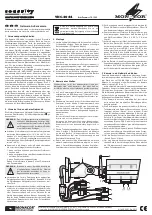
212
C H A P T E R 7
The Stereo Data Maker (SDM)
Transmission begins by sending a start bit with a pulse width of 4. 24
data bits (3 bytes). A 0-bit is encoded with a pulse width of 1, a 1-bit with a
pulse width of 2. The space between two bits has the length of one pulse.
After the bit sequence, a space with a pulse width of 3 follows. Then the
above sequence is repeated. The receiving device should compare both se-
quences, and in the case of equality, acknowledge successful reception at
the USB port. In the case of inequality, no action needs to be taken—the
SDM command for receipt at the USB port will simply time out.
The pulse width can be set in
ALT
>
MENU
>
Advanced
>
Serial Comms
and should be between 10 msec and 20 msec. At the beginning of a com-
munication, a script will typically send a reference pulse (command
unit_
pulse
) that allows the external device to calibrate to that pulse width.
Because the real pulse width differs from the specified value (depending on
the camera’s processor), the menu offers the ability to fine-tune the pulse
width. This is done by trial and error, or by analyzing the signals with an
oscilloscope
2
.
This serial communication facility is typically used for controlling exter-
nal devices with a camera script, such as robotic camera platforms or rigs.
An interesting project for building a DIY panoramic robot head is found on
www.instructables.com/id/Camera-Panorama-robot-head-panograph/
.
Of course, it is also possible that an external device will send more data
to the camera’s USB port than a simple receipt. Such data can be encoded
with pulses of varying width and interpreted with the help of the script
command
get_usb_power
(section 5.5.10).
7.7
Stereo photography
The SDM was designed for stereo photography. When we look at nature to
see how 3D vision works, we soon find that in almost every case two im-
ages taken at different positions are compared with each other. For exam-
ple, humans have two eyes set at a distance of approximately 70 mm apart.
Our eyes compare images simultaneously, allowing us to perceive move-
ment in space very well.
Other animals have eyes that are oriented sidewise. In that case, it is
often impossible to compare the images from both eyes simultaneously
because each eye sees a different part of the scene. Instead, such animals
compare images obtained before and after a movement. Take, for example,
a chicken: a first look, a quick move of the head, then a second look. The
faster the head moves, the better the comparison between images works.
Now you know why a chicken walks like a chicken.
2 The
Visual Analyzer
from
www.sillanumsoft.org
teamed with the sound
card of your computer makes a capable and free oscilloscope.
Figure 7-4
The
Serial Comms Data
submenu
controls the pulse width for serial
communications via the blue LED.
Summary of Contents for Camera
Page 1: ......
Page 2: ...The Canon Camera Hackers Manual ...
Page 3: ......
Page 4: ...Berthold Daum The Canon Camera Hackers Manual Teach Your Camera New Tricks ...
Page 19: ...10 CH APTER 2 Cameras and Operating Systems ...
Page 25: ...16 CH APTER 3 ...
Page 85: ...76 CH APTER 4 Teach Your Camera New Tricks ...
Page 213: ...204 CH APTER 6 ...
Page 253: ...244 AP PENDIX ...
















































